Rev. Francis Bellamy penned the Pledge of Allegiance in 1892 – assisted by the patriotic teachers of the National Education Association
Influential Baptist minister Rev. Francis Bellamy wrote the Pledge of Allegiance in 1892. It quickly became a ritual of school days across the United States thanks to an enthusiastic assist from the National Education Association.
Reverend Francis Bellamy penned an optimistic promise to unite a vast and growing nation.
The New York native, gifted orator and Baptist minister wrote the Pledge of Allegiance
"I pledge allegiance to my Flag and the Republic for which it stands, one nation indivisible, with liberty and justice for all," Bellamy’s American credo read it in its initial 22-word incarnation.
That very same patriotic paean has in recent decades become a divisive flashpoint in the modern American culture war. Its evolution highlights what many believe is a dramatic reversal of mission among the nation's largest education organization.
The Pledge of Allegiance appeared for the first time on Sept. 8, 1892 in influential national children’s publication "The Youth’s Companion," for which Bellamy worked.
Bellamy championed the cause of the pledge two months earlier, however, in front of a powerful audience of influential teachers and self-proclaimed patriots.

Rev. Francis J. Bellamy (1855-1931) wrote the Pledge of Allegiance for "The Youth's Companion" in 1892. He later championed the call for unity by enlisting the aid of the National Education Association. ("Campbell's Illustrated History of the World's Columbian Exposition," Vol. 1/Public Domain)
The National Education Association proved his greatest ally in sharing the pledge.
"Talk about patriotism in the schools is not enough," Bellamy said before NEA members at the organization’s 1892 annual meeting on July 12 in Saratoga Springs, New York.
"The time has come when the highest ideals of American citizenship should be made part of the curriculum." — Francis Bellamy
Dignitaries that day included President Benjamin Harrison, who addressed the teachers with equal patriotic fervor.
Bellamy beseeched the nation’s educators, "The time has come when the highest ideals of American citizenship should be made part of the curriculum, in the high school of course, and in the grammar school and the little schoolhouse on the country road as well."
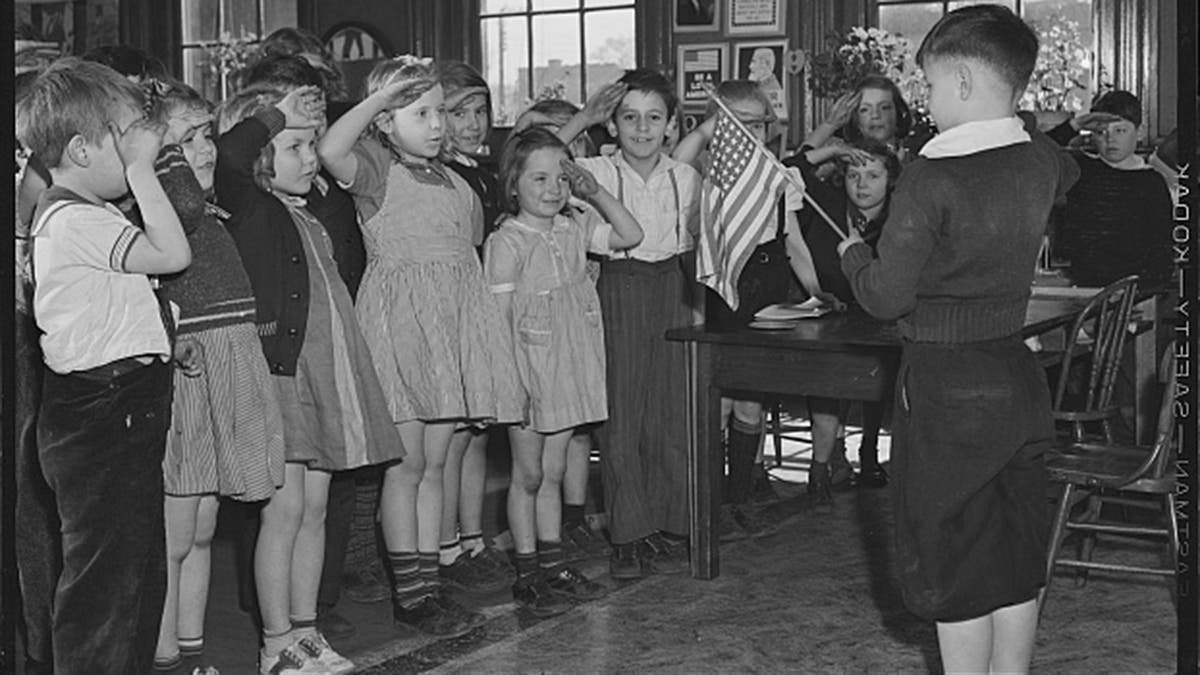
Students recite the Pledge of Allegiance in Norfolk, Virginia, 1941. (Photo by John Vachon via Library of Congress/publc domain)
The Pledge of Allegiance was soon recited in almost every schoolroom in America, thanks to the warm pro-American embrace of the nation’s most powerful teachers union.
In 2023, the NEA champions on its website "gender empowerment," "racial justice" and "LGBTQ+ Support & Protection."
Fox News Digital reached out to the NEA for comment and response.
"It is no surprise that Bellamy used the NEA to promote the pledge," former U.S. Department of Education Secretary William Bennett told Fox News Digital this week in an interview.
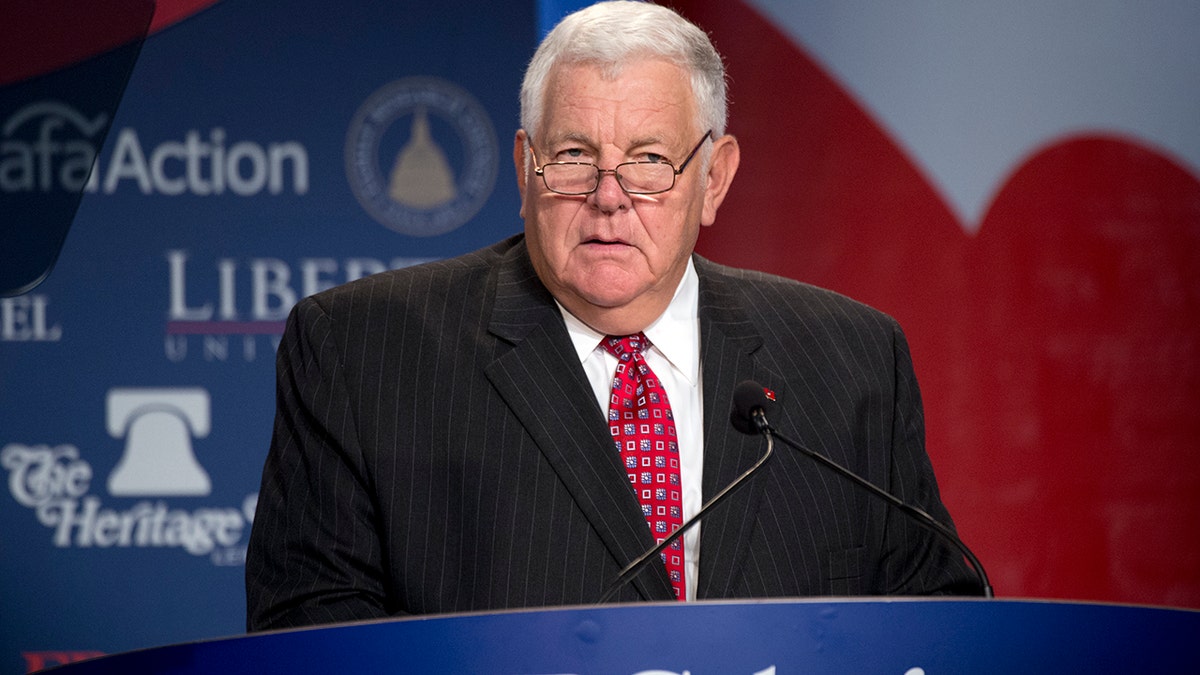
Bill Bennett, former education Secretary, addresses the Values Voter Summit at the Omni Shoreham Hotel in Woodley Park, Washington, D.C. (Tom Williams/CQ Roll Call)
"It was once a patriotic-affirming organization dedicated to the same causes that today they would cast as extreme conservatism," Bennett said.
The Pledge of Allegiance has faced legal challenges from teachers, private citizens and other organizations, though not from the NEA. (SEE the video at the top of this piece.)
‘America must be another name for opportunity’
Francis Julius Bellamy was born on May 18, 1855, in Mount Morris, New York, to Baptist minister Rev. David and Lucy (Clark) Bellamy.
He was raised in Rome, New York, where the family moved when he was 5 years old.
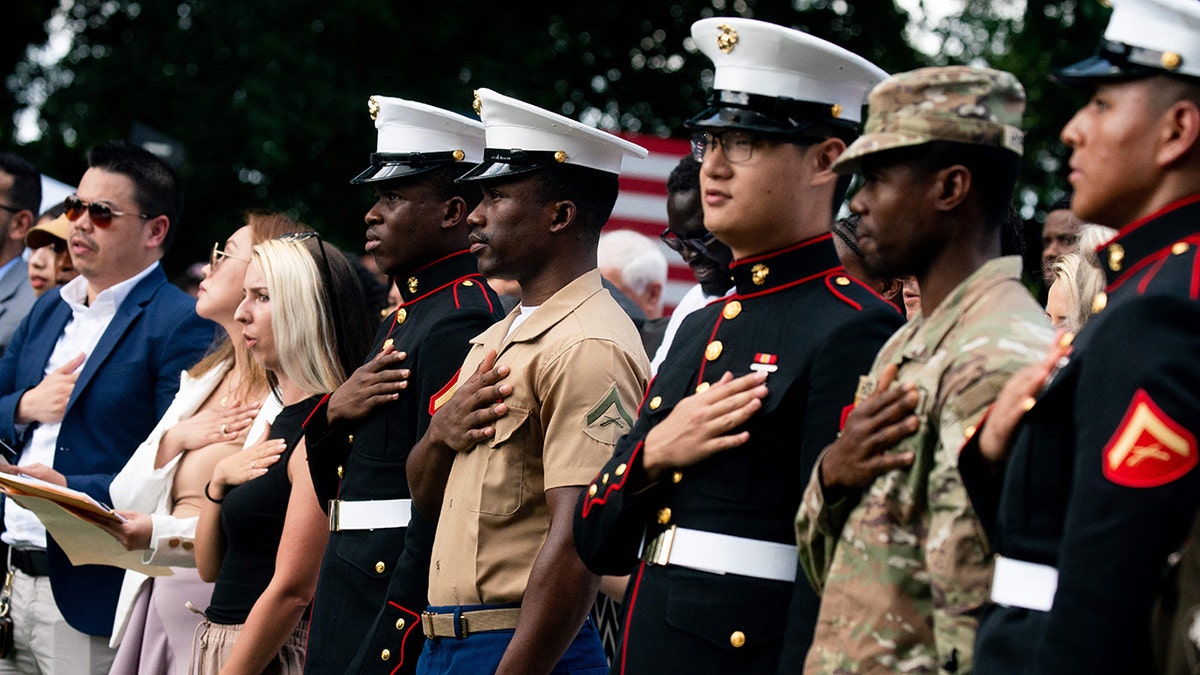
New U.S. citizens recite the Pledge of Allegiance after being sworn in during a naturalization ceremony on Independence Day at George Washington's Mount Vernon in Mount Vernon, Virginia, on July 4, 2023. (STEFANI REYNOLDS/AFP via Getty Images)
"Educated in public schools, he distinguished himself in oratory at the University of Rochester before following his father to the pulpit, preaching at churches in New York and Boston," Smithsonian Magazine wrote in a 2003 biography.
Bellamy’s nuanced politics defy the convention of today to define everything along a simplistic binary narrative.
He was a self-proclaimed socialist yet an advocate of American individualism — a Bible-thumping minister yet a champion of secular progress.
"He distinguished himself in oratory at the University of Rochester before following his father to the pulpit." — Smithsonian Magazine
Bellamy was, first and foremost, a patriot and a faithful advocate of American exceptionalism.
"The true Americanism," he told the NEA, "is a joyous sense that America must be another name for opportunity."

A special edition cover of "The Youth's Companion" celebrating the Chicago World's Fair of 1893. The influential children's publication popularized both Columbus Day and the Pledge of Allegiance starting in 1892. (Yale University Library/Public Domain)
Smithsonian Magazine added, "He was restive in the ministry and, in 1891, accepted a job from one of his Boston congregants, Daniel S. Ford, principal owner and editor of 'The Youth's Companion,' a family magazine with half a million subscribers."
The publication touted contributions from leading literary luminaries of the 19th century, including Emily Dickinson, Mark Twain and Booker T. Washington.
Bellamy, among other duties, was charged with helping the magazine sell American flags.
The pending 400th anniversary of the arrival of Christopher Columbus in the Americas provided the publication with a once-in-four-century opportunity to promote both patriotism and profit.
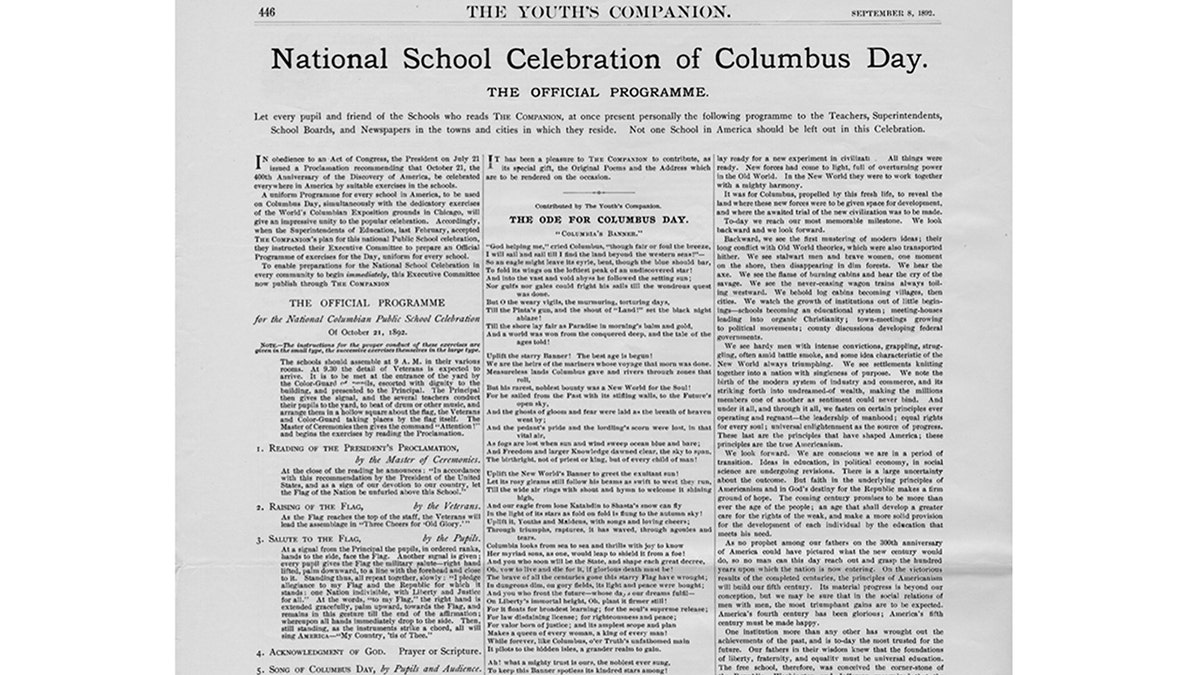
The Pledge of Allegiance was published for the first time on Sept. 8, 1892 in "The Youth's Companion." It appears in the left column under heading number three, "Salute To The Flag." The Pledge of Allegiance was part of a wider effort by the publication to celebrate the 400th anniversary of the first Christopher Columbus expedition to the New World in 1492. (Public Domain)
President Harrison in June, authorized by Congress, proclaimed Oct. 21 the first celebration of what we now know as Columbus Day.
"On that day let the people, so far as possible, cease from toil and devote themselves to such exercises as may best express honor to the discoverer and their appreciation of the great achievements of the four completed centuries of American life," stated the presidential proclamation.
"The true Americanism is a joyous sense that America must be another name for opportunity." — Francis Bellamy
"The Youth's Companion" set about shaping the celebration for the nation, including a schoolhouse "salute to the flag" highlighted by Bellamy's Pledge of Allegiance.
The date Oct. 21, 1892, proved a landmark day in American cultural history: Both Columbus Day and the Pledge of Allegiance were celebrated for the first time.

Rendering of Christopher Columbus arriving in the Americas in 1492. Chromolithograph by Louis Prang and Company. (Getty Images)
Bellamy was at the center of both events.
"Millions of schoolchildren nationwide took part in the 1892 Columbus Day ceremony, according to 'The Youth's Companion,'" writes Smithsonian Magazine.
"Bellamy said he heard the pledge for the first time that day, Oct. 21, when ‘4,000 high school boys in Boston roared it out together.’"
NEA’s ‘loyal and patriotic citizens’
The National Education Association ensured that Bellamy's Pledge of Allegiance swept the nation. The pledge was soon a daily part of schoolhouse ritual from sea to shining sea.
The NEA was founded in Philadelphia in 1857. It had grown to 300,000 strong by the time of its annual meeting in 1892; it numbers 3 million members today, and is the largest union in the United States.
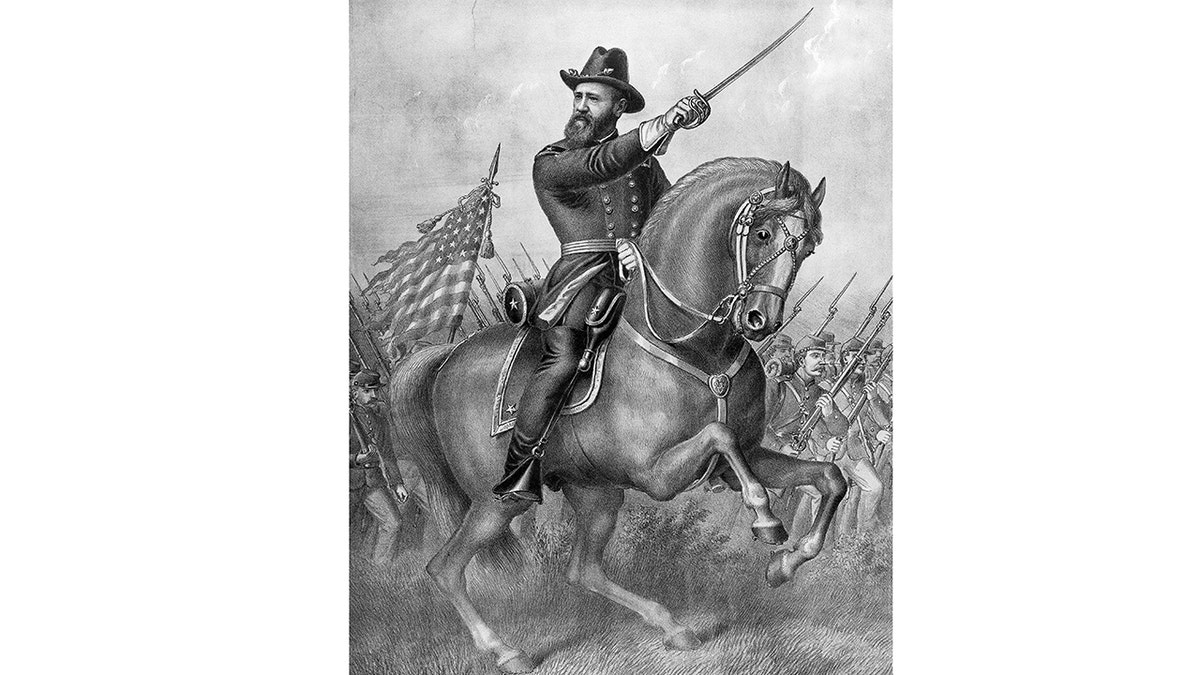
Benjamin Harrison (1833-1901), 23rd president of the U.S., served with distinction during the Civil War, returned in 1865 as Brigadier General. Shown in an undated illustration. (Getty Images)
The NEA's mood in Saratoga Springs that summer was one of red, white and blue fervor.
"We are loyal and patriotic citizens," NEA executive and New York State Superintendent of Public Schools Andrew S. Draper said in welcoming remarks.
"We are loyal and patriotic citizens." — NEA executive Andrew S. Draper
"We know the history, we recall the cost, and therefore we appreciate the value of our distinguishing American institutions."
Civil War hero-turned-23rd U.S. President Benjamin Harrison cited in his keynote address the power of teachers to forge a vast and diverse continent of children from many cultures into a unified nation.
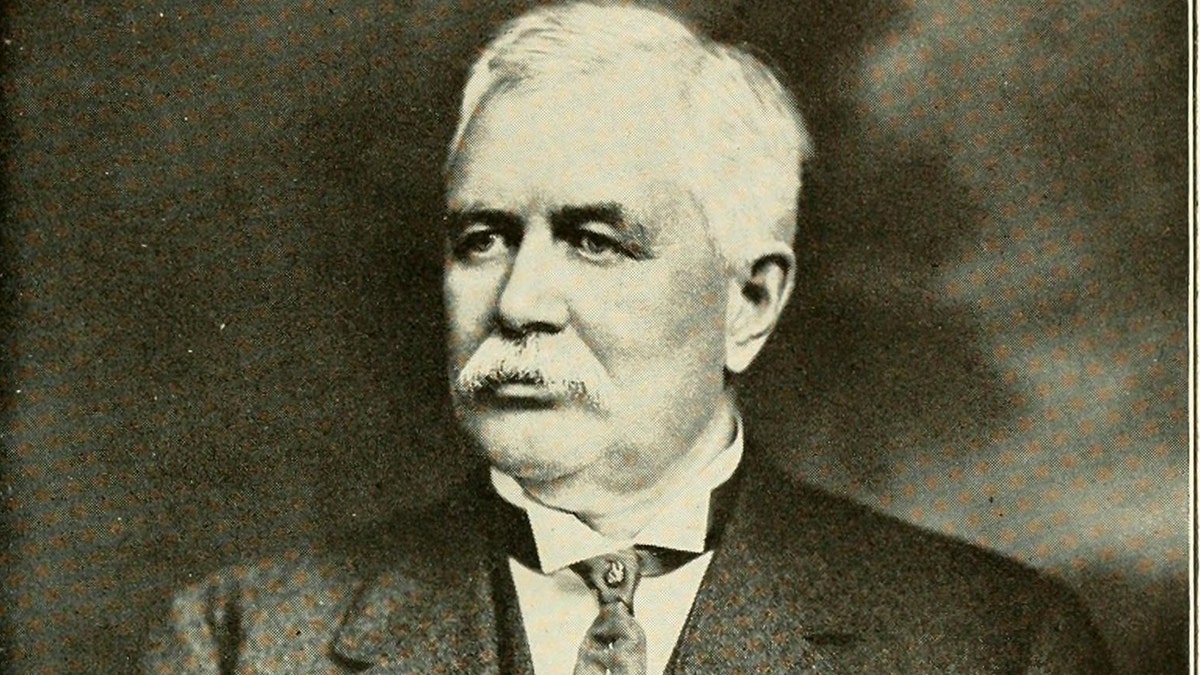
Andrew S. Draper was a one of America's leading educators of the 19th century and an executive with the National Education Association. "We are loyal and patriotic citizens," he said before President Benjamin Harrison at an NEA meeting in 1892. (From "New York’s Part in History" (1915) by Sherman William/Public Domain)
"The strength and defense of our institutions, not only in peace but in war, is to be found in the young of the land, who have received from the lips of patriotic teachers the story of sacrifice which our fathers recorded to establish our civil institutions, and which their sons have repeated on hundreds of battlefields," the president told the NEA members.
The commander-in-chief touted his wartime experience to make the case for instilling in children personal fortitude and love of country.
MEET THE AMERICAN WHO WROTE ‘THE BATTLE HYMN OF THE REPUBLIC’
"I recall a battle scene. There was a pause that threatened instant retreat, when a stripling soldier, a mother’s boy, stepped to the front with cap in air, cheered the line on to victory. The instinct of patriotism, of moral courage, was triumphant over mere physical daring in that hour, and it always will be."
Bellamy used the opportunity of the favorable audience of teachers to strike hard on behalf of his pledge.
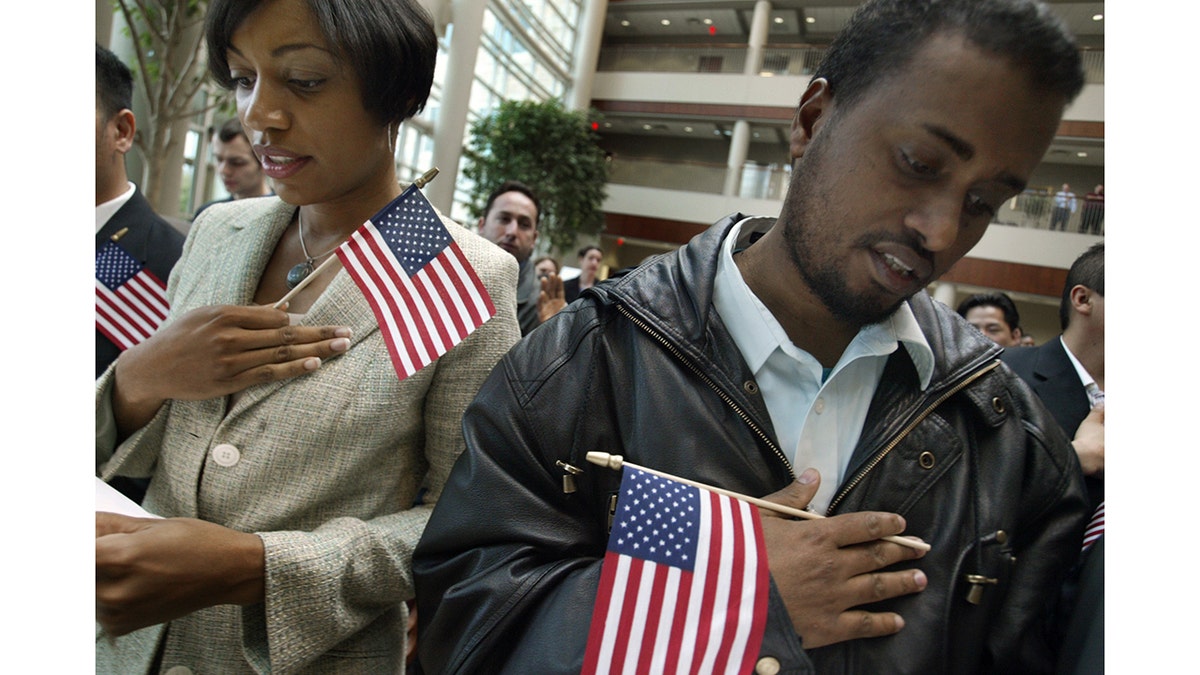
Two individuals recite the Pledge of Allegiance during a naturalization ceremony in Minneapolis, Minnesota, on March 30, 2005. (STORMI GREENER/Star Tribune via Getty Images)
"The flag over the schoolyard makes the nation a real thing to the very ones who are most in want of that lesson. The daily ceremony of raising it and saluting it is a perpetual education."
The, he added prophetically, "The schoolmaster holds the future of American politics, with the general increase of Americanism all around him."
"The schoolmaster holds the future of American politics." — Francis Bellamy
Yet the nation's schoolmasters today appear to champion anti-Americanism more than Americanism, according to Bennett, former Education secretary.
The "future of American politics" as predicted by Bellamy has changed with it, he suggested. "There is a quote attributed to Abraham Lincoln," said Bennett, "that the philosophy of the schoolroom in one generation will be the philosophy of the government in the next."
MEET THE AMERICAN WHO GAVE THE NATION OUR THANKSGIVING ORIGIN STORY: PILGRIM EDWARD WINSLOW
The NEA remained patriotic through the 1950s, the secretary believes, before a cultural "self-loathing" begin to infect many aspects of American life, including education and academia.
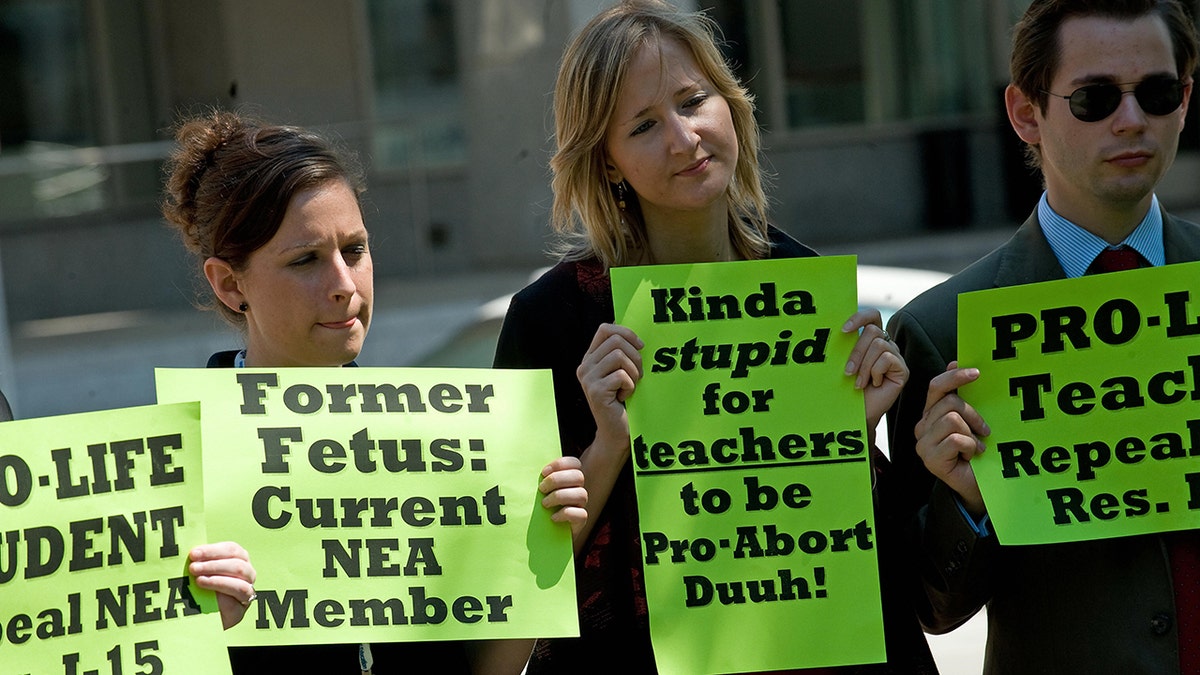
The National Education Association is embroiled in many aspects of the American culture war, including the fight over abortion. Pro-life members of the NEA who protested the organization's pro-abortion stance are shown outside the Washington Convention Center on July 2, 2008. (NICHOLAS KAMM/AFP via Getty Images)
"What happened to the NEA is not so different than what happened to the university," said Bennett. "
They became contentious of their own heritage and their own legacy. And they look at this contention as a mark of their sophistication."
"What happened to the NEA is not so different than what happened to the university. They became contentious of their own heritage and their own legacy." — William Bennett
This decline in faith in the nation among teachers, noted Bennett, has coincided with a measurable decline in the welfare of America's children and the quality of American education.
The ever-changing pledge
Rev. Francis Bellamy died at his home in Tampa, Florida on Aug. 28, 1931. He was 76 years old.
His birthplace in Mount Morris, New York, was memorialized by the State Board of Education in 1939, noting the significance of his pledge. He's been honored with many other memorials in Rome and Rochester, New York, where he was raised and educated.
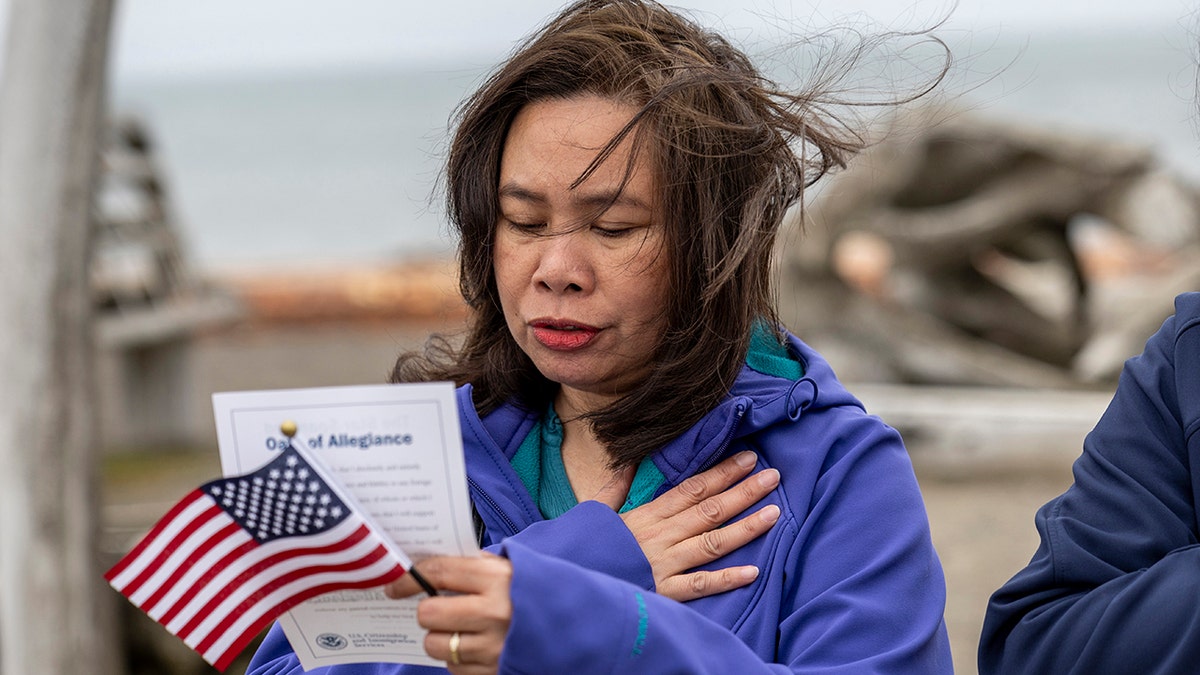
Immigrants recite the Pledge of Allegiance to the United States during a naturalization ceremony held in front of the "Gateway to the Arctic" whale bone sculpture on Aug. 10, 2023 in Utqiagvik, Alaska. (John Moore/Getty Images)
His pledge has undergone numerous changes — and challenges over the years.
The words "the Flag of the United States of America" were added in 1923.
Congress officially adopted the Pledge of Allegiance as part of a national flag code in 1942, as patriotism soared in the early days of World War II and the United States celebrated the 50th anniversary of the pledge.
The ceremony that accompanied the pledge changed during World War II as well. Bellamy originally called on citizens to lift their right arm and point it upward toward the flag as they recited the pledge.
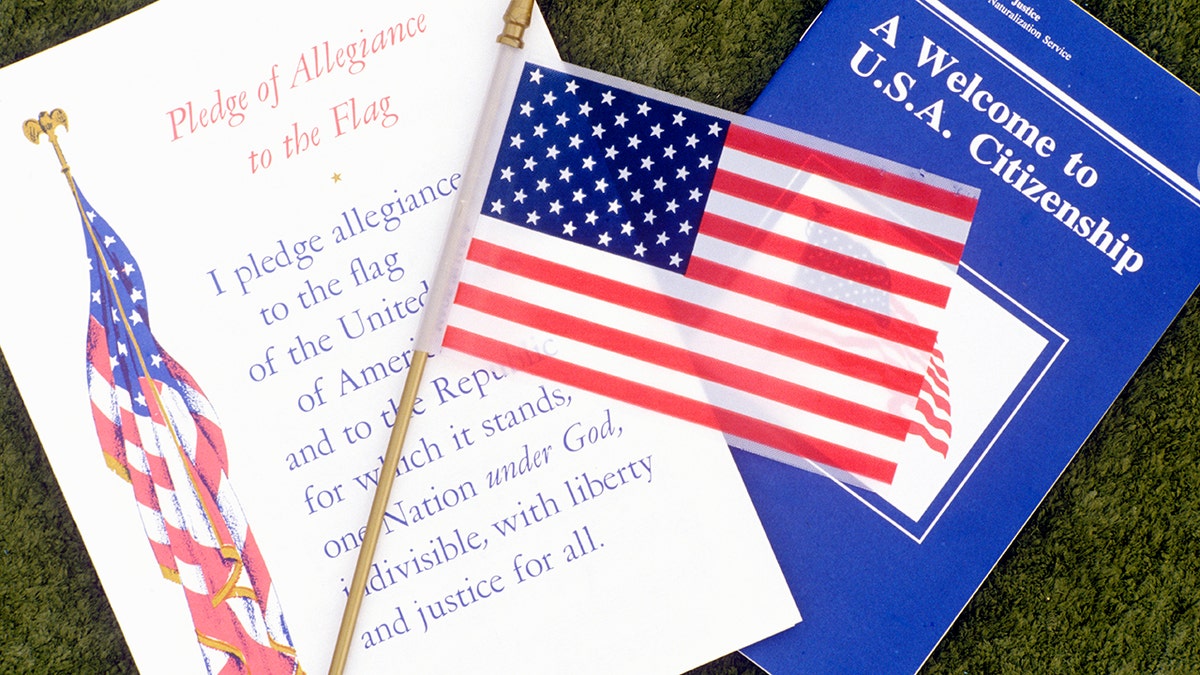
The Pledge of Allegiance with American flag, Los Angeles, California. (Joe Sohm/Visions of America/Universal Images Group via Getty Images)
The upraised right arm was quickly replaced by the now-familiar right hand over heart when newsreels showed Hitler's fanatical National Socialists saluting him with the same upraised right arm.
The pledge underwent its most dramatic and contentious change in 1954.
CLICK HERE TO SIGN UP FOR OUR LIFESTYLE NEWSLETTER
President Dwight Eisenhower encouraged Congress to add the words "under God" at the height of the Cold War against the "godless" Communist Soviet Union.
"I pledge allegiance to the flag of the United States of America, and to the republic for which it stands, one nation under God, indivisible, with liberty and justice for all," the pledge still reads today.
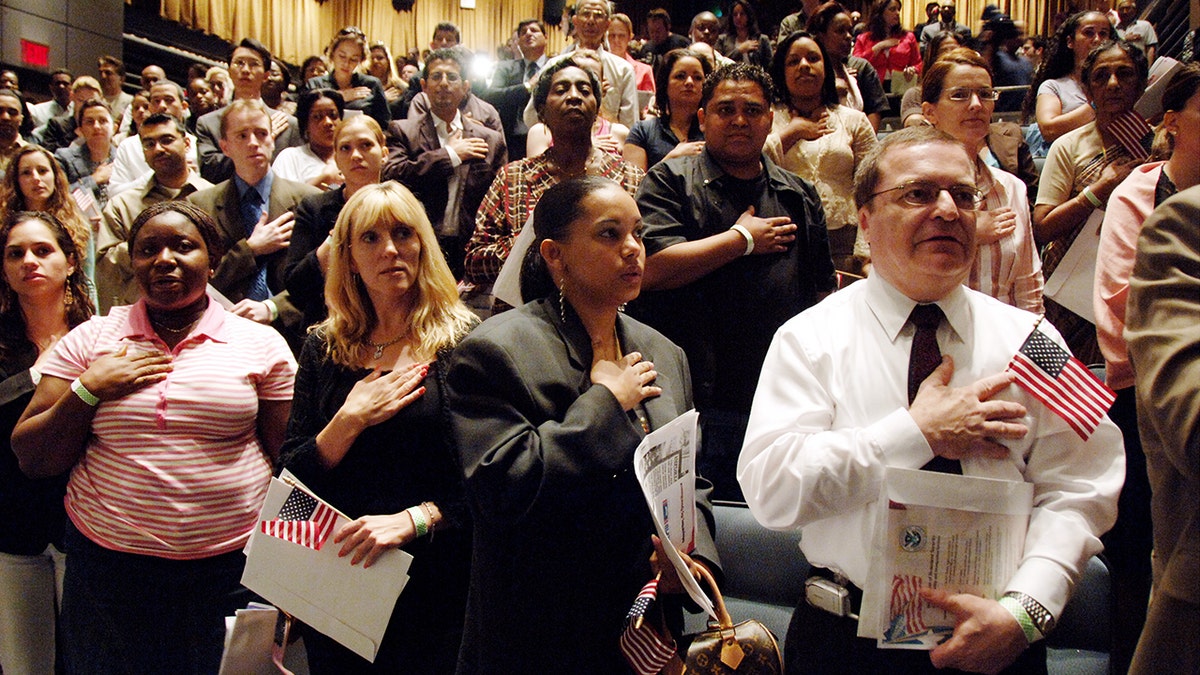
One hundred New York residents say the Pledge of Allegiance as they become U.S. citizens during a Flag Day ceremony at the Intrepid Sea-Air-Space Museum in New York City. (Susan Watts/NY Daily News Archive via Getty Images)
Fierce debate over the Pledge of Allegiance has reached the Supreme Court numerous times.
The high court, in various rulings, determined that children cannot be forced to recite the pledge in school; and several efforts to remove the words "under God" from the pledge have failed.
Through it all, Bellamy's Pledge of Allegiance endures, deeply ingrained in American culture.
"I pledge allegiance to the flag of the United States of America, and to the republic for which it stands, one nation under God, indivisible, with liberty and justice for all."
Millions of Americans recite the pledge before school, local board meetings and Rotary Club luncheons each and every day.
Perhaps most movingly, hundreds of thousands of newcomers to America recite Bellamy's Pledge of Allegiance each year, often in tears, when they gain a status coveted by millions of people around the world: United States citizen.
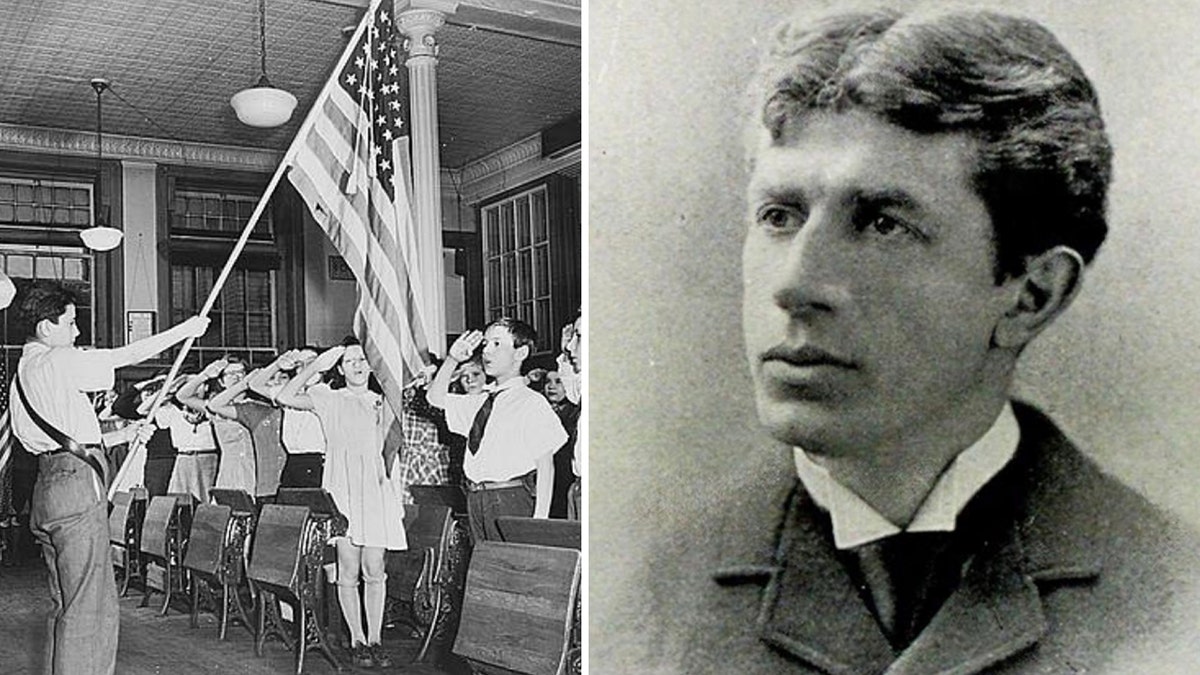
Children in New York City salute the flag while reciting the Pledge of Allegiance in 1943; Pledge of Allegiance author Rev. Francis J. Bellamy. (Student photo by Marjory Collins; Bellamy photo from "Campbell's Illustrated History of the World's Columbian Exposition," Vol. 1/Public Domain.)
The American flag, the object of the pledge, "is more than the symbol of the grandest republic on earth," Bellamy said before the NEA in 1892.
CLICK HERE TO GET THE FOX NEWS APP
"It is an education which in these days of individualism and special religious and secular interests is tremendously needful to remind our citizens of common obligations in a common country."
The video at the top of this article has been updated.
To read more stories in this unique "Meet the American Who…" series from Fox News Digital, click here.





















